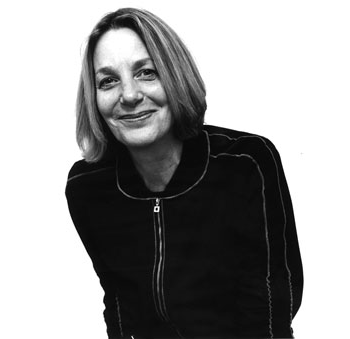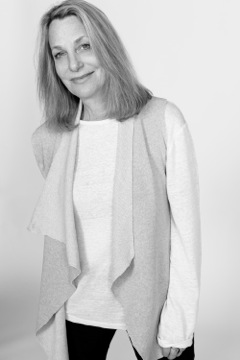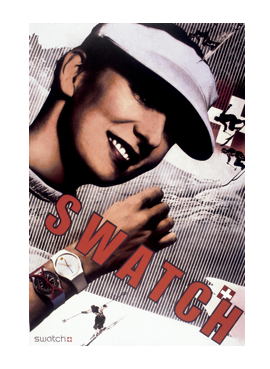Paula Scher
Designer, Artist & Educator

Intro
Paula Scher has been a huge part of graphic design for over 30 years now. She was born in Virginia on October 6th 1948 and grew up in Philadelphia and Washington. Since then Scher has developed her work through design, painting and educating and is widely known for pushing the boundaries of design. Paula also became the first female Principle at the New York office of the Pentagram design consultancy in 1991.
Paula was always interested in design and as a child she would use drawing as a reason to go off to her room and spend some alone time. Even now Paula feels that drawing and painting allows her to escape from everyday life and gives her a sense of satisfaction. She remembers as a small child always being aware of design and how she recalls seeing an early cover for South Pacific and wondering why the faces were cropped off in an odd shape.
"As a child I wanted to be a singer, dancer, piano-player and bare back rider. When I got to be older and realized I wasn’t a beauty, I decided I wanted to be an artist. I didn’t know what a designer was - yet." - Paula Scher
There were no other artists in Scher’s family and her father, who was a photo-grammetric engineer and made all the government maps, was at first against Paula going to Art School. Her father was also an inventor and created a device called ‘stereo templates’, which is used a lot in Google Maps. Scher says she can remember him working on it in the basement of their house. Although Paula’s father was opposed to the idea of her attending the Tyler School of Art she took a lot of inspiration from him and he was the main reason she later really got into painting maps.

Scher’s Mother was also skeptical of the idea of Paula attending an art school and made her finish a teaching certificate so she would have something to fall back on if her career in design didn't work out. When Paula told her mum she had plans to go to New York and become a professional designer her mum simply replied ‘Don’t do anything like that, it sounds like it takes talent.’. Paula certainly ignored her mother’s comments and went on to have an amazing career.
Education
Scher attended high school in Washington where she was the ‘school artist’, and would make her friends paper dolls and comic strips. She also took weekend art classes at Corcoran College of Art and Design. Paula’s love for art and design meant that she quickly became the school’s publicity chairman and made all the advertising posters for events such as school dances.
"When I was in high school, I took weekend art classes at Corcoran College of Art + Design, but I kept that to myself because it wasn’t a cool thing to do." - Paula Scher
After high school Paula Scher followed her passion for art and design and attended the Tyler School of Art in Elkins Park Pennsylvania. At this time Scher felt that she couldn't draw well but soon learnt to illustrate her different concepts well with type.
During her time at Tyler, Scher loved experimenting with drawing, painting and printmaking, but feels that she didn't find her own style until she did a course called Graphic Design in her junior year. In this course Paula did a lot of problem solving projects and created lots of abstract pieces using different symbols and shapes. At this time her teacher was Stephen Tarantal who was a painter and designer. He gave her Basel basics which involved looking at layout and shape. She would carry out tasks such as moving a black square around a white page to study form and visual messages. Paula was also taught the the Swiss International Style of typography, Helvetica on a grid.
“I went to college thinking I was going to be a painter, but I couldn’t really draw, so I tried other things…It seemed like I wasn’t good at anything, but then…I discovered graphic design.” - Paula Scher
Scher then started to veer towards illustration over graphic design because she felt her work was too ‘sloppy’ and didn’t like arranging Helvetica on a set grid. Scher decided to go on to major in Illustration and had a teacher called Stanislaw Zagorski, who she feels influenced her whole life. Although Paula decided upon illustration she was frustrated as she could never do the typography on her projects, she would come up with a concept and then try to illustrate it but never liked the finished outcome. Stanislaw first gave Paula the idea to illustrate her concepts with type. As she experimented with this idea Scher began to learn a lot about type in relation to image.
Paula’s biggest influence in school was Push Pin, she describes them as being her ‘heroes’ of the time. She was inspired by them because they combined illustration with typography, and used lettering from historical periods that Paula identified with. She loved to use wood type and try out different variations of Victorian graphics. Paula Scher finished her studies at the Tyler School of Art and obtained a Bachelor of Fine Arts in 1970.
Career
Paula Scher graduated from Tyler School of Art and started off her long career when she first moved to New York City in 1970. She went with just her portfolio and $50 in cash. She took her first job designing the layouts of children’s books for Random House. In 1972 Paula got a job in the advertising and promotions department of CBS records. At the time, the department Paula was working in wasn’t giving her the work she wanted, which was a job designing covers, so she left CBS Records and landed a job at Atlantic Records.
She moved companies because Atlantic Records housed promotions and covers in the same department. Paula Scher became the art director here and began designing her first album covers. She worked at Atlantic for one year, and then at 25 years old returned as the East Coast Art Director for the cover department at CBS Records.
Paula worked with CBS for the next 10 years with 2 years in between at Atlantic Records, and had the responsibility of designing up to 150 album covers a year. These were in a 12x12 format and included Boston Boston, Roger Dean and David Howells The Ultimate Album Cover Album, Bob James H and Eric Gale Ginseng Woman. Some of these covers became iconic designs and in addition her designs were recognised with four Grammy nominations. During her time as Art Director at CBS Scher learned how to work in every style and became fascinated by period typography. At lot of Paula’s work done in the late 70’s is now referred to as being part of the postmodern movement and her experimentation with early modernist type and image shows this.

Paula’s concept was to copy a typographic style and turn it into a record cover. In the late 1970’s there was an economic crash, and as Art Director Scher could no longer afford to put all of the departments money into imagery and therefore decided to focus on type. A lot of Paula’s work was influenced by the 30’s through Art Nouveau and Constructivism and she began to develop a style of decorative typography integrated with imagery. She approached her work by designing things that were contemporary and well liked at the time with the aim of appealing to people in the cover design itself to make them interested in buying the record. A lot of the inspiration for her typographic album covers came from things like a Buckingham Pipe Tobacco tin. Scher would also make a hobby of buying old sheet music and copying the typography.
"Type is image" - Paula Scher
Working in the music industry also taught Paula how to present her work. The recording artists Scher was working with had contractual cover approval, which meant that Scher had to present her ideas and finalised product to them before they could agree it. This allowed Paula to learn very early on how to explain and show her work to others and get them to understand and appreciate it. This has been a huge benefit to Scher throughout her career because she has the skills to get people to like her work and therefore sell it. In 1982 Paula decided to leave CBS Records to clasp the pressures of working on her own.
“It’s through mistakes that you actually can grow. You have to get bad in order to get good.” - Paula Scher
After Paula left CBS she became less focused on illustrative imagery and more so on just pure type. Scher says she feels much more in control if the project she’s working on is just type. Although 90 percent of what Paula does now is type there are still instances where she will take up an illustration project. Paula Scher's style now brings to mind bold imagery and her use of type is a lot more illustrative rather than print style.
In 1984 along with Terry Koppel, Paula Scher formed the studio Koppel & Scher. Terry was an editorial designer and fellow Tyler graduate of Scher’s. During the seven years of Koppel & Scher Paula produced brand identities, packaging, book covers, and advertising, including her famous Swatch poster based on Herbert Matter’s previous work. Paula described the work she did there as a balance of editorial design and promotion packaging and covers. In 1990 Terry left the partnership and took a job on at Esquire. Paula then ran the business herself for about a year until a man called Woody Pirtle who was a partner at Pentagram visited her studio and asked her if she would be interested in joining them. The experience of being involved in a successful partnership showed Paula the challenge of keeping her own clients and keeping on top of an small organised company.

Paula was interested in the offer Woody gave her and became a partner in the New York office of Pentagram in 1991. Pentagram is a world-class, large-scale studio and brought Paula the space and visibility she needed to create new work and produce new ideas. After moving to Pentagram Paula had access to clients and projects that would not have normally come to a smaller studio, such as Koppel & Scher. Paula Scher's work has involved corporate identity and branding for some major clients. These include Citibank, Coca Cola, CNN, Windows 8 and Bausch + Lomb.

The time Scher has spent working within Pentagram has allowed her to develop her typographic skills and her instinct for problem solving. You can easily see how the move to Pentagram developed Scher as a designer through the contrast of her early work and current work. Instead of being entered around the design of a neatly comprised package for a particular product, Scher now tackles a much larger array of designs which bring out her personality across a range of media such as posters, packages and physical spaces.

Designer Seymour Chwast was a huge influence on Scher throughout her career and they first met in 1970 with Paula’s portfolio. He created work that saw a clever blending of imagery and type. As well as take a lot of inspiration from Chwast’s work Paula Scher also married him - twice. Once when she was 25 and again when she was 40. When they divorced Scher built a life and career on her own in the competitive design world and created an individual style and name for herself.
Educator
In 1992 Paula began teaching at the School of Visual Arts in New York as a design educator. She has taught in New York now for over 20 years along with positions at the Cooper Union, Yale University and her former college, Tyler School of Art.
Brand Identity
One of Paula’s greatest achievements was being the first designer to create a new identity and different promotional graphics for The Public Theater in 1994. This included creating the logo, large-scale billboards, posters and even stationary. To do this Scher used a lovely blend of sans serif type to create a graphic language and graffiti-like style blended with traditional woodcuts. This helped the theatre to appeal to a more urban population.
When Paula Scher started the project of giving The Public Theatre a new identity she knew that the organisation was greatly linked to Joseph Papp. Scher saw a big problem with this as Joseph Papp was dead and this gave out the impression that the theatre was dead too. Paula admired the previous work of Paul Davis’s but she felt like she needed to start over to rebuild a new, fresher image of the Public Theatre. Scher went in a completely opposite direction and focused mainly on type so her work would be easily differentiated from that of Paul Davis. Paula submitted three logos and George Wolf, the director, picked the boldest one. She wanted to make the word ’Public’ as big as possible so that people would know they were going to the Public Theatre.

The work Paula did for the Public Theatre went on to pick up the Beacon Award in 1996. In addition to this Paula has also provided all of the identity work and design for promotion for the Theatre's long-running Shakespeare in Central Park series since the early 1990s.
Fine Art
As well as being a successful designer Paula Scher is also known as an artist for her large paintings of maps covered with closely packed hand painted labelling and information. Scher began painting these colourful typographic maps of the world in 1990. They consisted of the world’s continents, countries, islands, streets and neighbourhoods. These sparked up controversy and represented information overload and the constant stream of news we are often subjected to. Paula released her book ‘MAPS’ in 2010 where the 39 paintings are collected for the first time in. Many of Paula Scher’s original paintings are massive and as tall as 12 feet. Her map project is by far my favourite work she has done to date.
"I began painting maps to invent my own complicated narrative about the way I see and feel about the world. I wanted to list what I know about the world from memory, from impressions, from media, and from general information overload. These are paintings of distortions.” - Paula Scher

Conclusion
Having lectured and exhibited all over the world, Paula Scher still works at Pentagram where she continues to design new things and create new concepts. She also still works as an educator, writer and artist and has received hundreds of prestigious design awards for her work over the years. This includes ore than 300 awards from international design associations in addition to a string of awards from the American Institute of Graphic Design. She believes that graphic design is timeless and this shows as many people continue to remember the cover she did for Boston’s debut album 39 years ago.